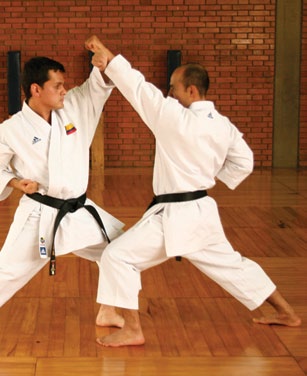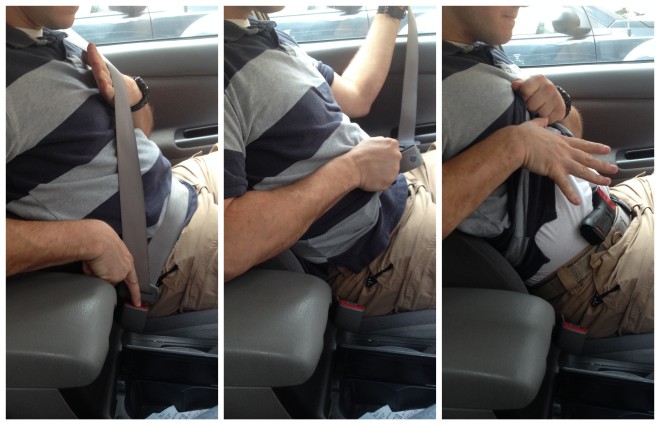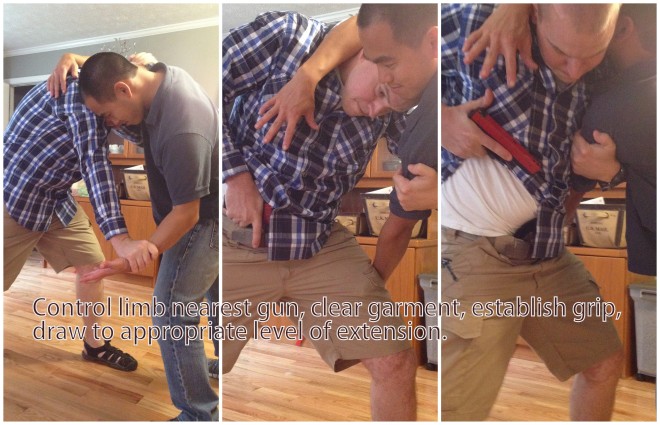The proliferation of Instagram and Youtube shooting sensations has brought with it a disturbing trend. I have noticed that in MANY of the shooting I’ve seen in the 15-60 second cherry picked drills they decide to post, they use the ‘speed rock’ retention position for contact distance shooting. Then they show you their timer to show how quickly they can complete a contact distance drill. This is an oversimplification of the problems that arise in this contact distance situation. I have to set the record straight because people are actually watching this stuff and considering it to still be legitimate technique. Long story short, it’s not.

Here’s one IG example so we’re on the same page. Watch his posture as he leans back and back pedals away from the target. Boy howdy, he sure is fast!!! Unfortunately, this is more than a speed shooting problem.
Note: This is nothing against this guy. He's a better shooter than I'll ever be. I just don't want people to think this is viable against a resisting opponent. When you get to initiate a sequence against stationary targets with no free will, ANYTHING will work. Add another human and things get more slippery.
Here’s the issue…The Speed Rock is a POOR technique!
What is the Speed Rock?
From The Tactical Pistol 1996 “The “speed rock” refined for combative use by Chuck Taylor is a last-option technique for arm’s length situation where there is no room to evade or maneuver. The shooter “rocks” the pistol out of the holster and simultaneously “rocks” his torso back to bring the muzzle onto the adversary’s vital zone”
So, 20 years ago, when folks were still really into the Weaver stance and mullets, this was the state of the art. So why was it a technique worth learning back then? It was the attempt to deal with the obvious real problem of a contact distance fight, in which so many police and citizens find themselves. It was an early beta technique which has evolved to higher percentage techniques. Here is a great article on its history.
It is FAST! You need only clear your duty holster, drop your elbow and bow forward at the hips to bring the muzzle slightly above horizontal, and you can start pressing the trigger as you back away. The more you drop your elbow and sacrifice your base with bowed hips, the more the impact zone will rise on the target. I think this is why the IG-speed shooter guys do it. Showing a timer after a drill like this seems impressive to their ignorant followers. Ignorant, not stupid. I’m trying to educate the ignorant.
Apparently it’s still taught by some very decorated guys from the special operations community. I will remind you that being really good at shooting people with a carbine in a military setting doesn’t necessarily directly translate to a criminal assault at a RedBox in front of a gas station when you’re wearing a subcompact gun under a T-shirt. It’s more than a shooting problem, it should be treated as a combative/grappling problem that happens to include weapons.
That, and Tom Cruise did it in Collateral…
Why it Sucks and You Shouldn’t Practice It
- The first and most important issue is the complete sacrifice of athletic base to achieve the position. Hips forward, torso back, weight on heels. Bad. This is the EXACT position you want your opponent to be in when you perform a body lock takedown.
- It is demonstrably easier to sustain an impact when in an athletic base (weight on balls of feet, nose over the toes, spine in alignment) than when your weight is on your heels (only people tripping over things backwards do this).
- The gun is actually NO FURTHER AWAY than it would have been with good technique. You have sacrificed your mobility and ability to sustain impact for ZERO extra distance. Bad trade.
- You can not move backwards faster than someone can charge you.
- Pistols suck at stopping people. Question: What does a person do after they are shot? Answer: Whatever they were doing before they got shot. Sacrificing mobility and your base for maybe 2 shots to the lower abdomen before you’re in a grounded gun fight is a bad trade. A motivated attacker will push through you and eat your lunch. Not to mention several attackers.
- The upward angle is meant to put rounds into the adversary’s thoracic cavity for a more reliable stop. The problem with this is that a miss at an upward angle means a bullet that can travel extreme distances. To demonstrate my point, watch Aaron Cowan of “Sage Dynamics” advocate stitching the target by breaking the wrist to achieve higher and higher shots. Three problems with this. One, when the other guy is moving, the floaty bent wrist index falls apart and it compromises wrist strength for retention. Two, where would those missed shots land when fired at an upward angle (edit: Aaron’s range is private land and has a large wooded area behind range)? Three, if your other hand is fending or tying the other guy up, you run the risk of shooting yourself in the arms and hands. Shooting yourself in a gunfight still counts.
- You’re probably not fast enough to make it work at arm’s length. I’m not. Not from concealment. This technique was designed for people who carry outside the waistband. You will eat so many punches/stabs at arm’s length that the trade isn’t worth it. You need to deal with the adversary’s forward drive and strikes FIRST. Then you get to shoot him.
- Since we understand the criminal assault paradigm, we realize that we likely will be engaged in some verbal judo with our adversary as he tries to close distance and find the opportunity to launch his ambush. This will create a cognitive load which WILL slow down our reaction time. So by the time you clear leather, he’s on you and you’re on the ground with your gun out. Bad trade.
- You’ll likely not initiate the shooting whether police or citizen. He/They will make the first move. You’ll likely be reactionary. This is the way of things when you’re the good guy. There are ways to spot pre-assault cues which will clue you in that something is about to happen, but good people have trouble being aggressive enough, fast enough.
- This won’t work in a confined space or against a wall. Your back has nowhere to go. The technique calls for ‘full retreat’ while shooting from the hip and leaning back. We live in a world of curbs, bumpers, bollards, and walls. That means tripping.
“What Do You Advocate Then, smartass?”
- I learned these principles from the Shiv-Works collective. Craig Douglas, Paul Sharp, Cecil Burch, Chris Fry, and Larry Lindenman. I have seen versions of the same postural cues and retention shooting from Active Response Training, Tactical Response, and a boatload of other schools and books. The good technique is so prevalent that I find it hard to believe the speed rock is still a thing, hence the post.
- If we make it our mission to try to stay upright, stay mobile, and most importantly, stay conscious, then we have a spring board to drive our technique.
- Adopt an athletic base. Hips low, nose-over-toes (weight on balls of feet), strong posture, aligned spine. Ready to deliver or receive forward drive.
- When you’re reacting to your adversary’s attack at this distance, it’s foolhardy to attempt to get your gun into play. You have to deal with his forward pressure and strikes/stabs FIRST.
- The less-than-ideal target zone of the hips and stomach serve to diminish our opponents ability to fight. As he soaks up rounds with no obvious recourse, his will to fight will fade, and you can improve your position and make more vital-area hits if required.
- The dropped elbow retention position is serviceable with good posture. Elbow retracted back as soon as you clear leather, forearm indexed along ribs, slight downward angle to shots. At least we know where they’ll land.

Greg Ellifritz from Active Response Training demonstrating a tight retention position along with a fending off-side arm. Note downward angle of shots, forward posture, and no intersection of muzzle line with shooter’s body. - I feel that an even more defensible and repeatable position exists. It’s simply the ‘count 2’ of the draw I prefer. Elbow retracted straight up and back, thumb flagged away from slide as a standoff, thumb indexed on the pectoral muscle, bunched tight trap muscle. This creates a repeatable downward angled shot path that won’t intersect in your other arm, which is probably fending or tied up with your adversary. It also works in the horizontal plane (read: on your back). Watch Craig Douglas work this position on the range. Video by Ballistic Radio.
- You might need to weather the initial storm of the attack. Learn a solid non-diagnostic default position to survive the first volley. Here’s a great article about options.
In Closing
These are the best methods I’ve seen and used in high pressure force-on-force training (which is as close as we can get to a gunfight without losing training partners). If you think I’m full of shit, I encourage you to get a bite guard, some MMA gloves, a blue gun, a buddy, and a grassy field and work it. If you’re near me, I’ll work it with you. Start slowly and ramp up the pressure until you have a competitive ‘gun-fight’ and see which method keeps you on your feet longer and absorbing fewer strikes. Test, refine, repeat.
Oh, and don’t believe everything you see on the internet.
Mark
If you find value in my posts, please consider subscribing and sharing. And please do your Amazon shopping through our affiliate link.





































